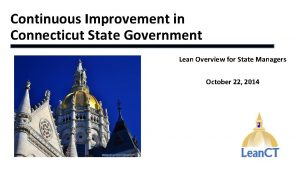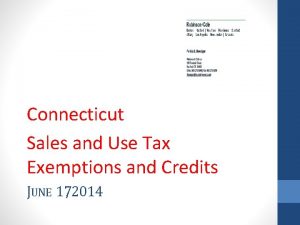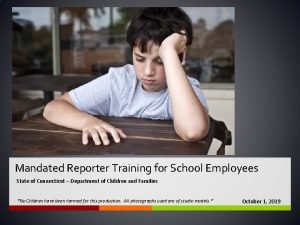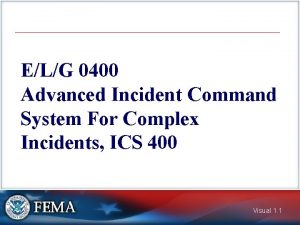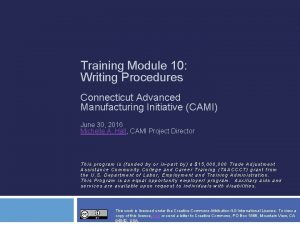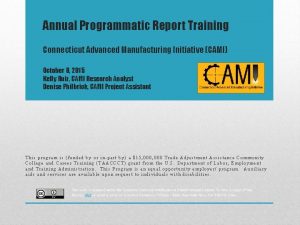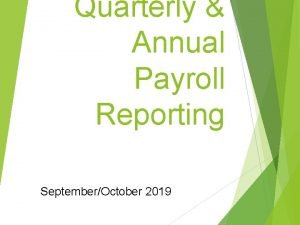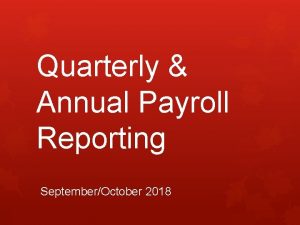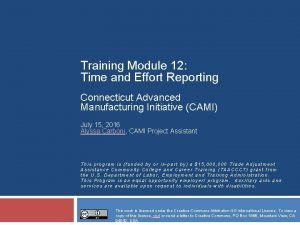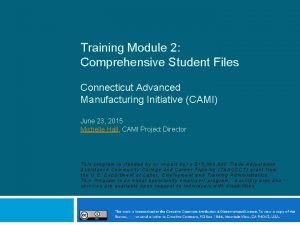Training Module 7 Quarterly Reporting Connecticut Advanced Manufacturing















- Slides: 15

Training Module 7: Quarterly Reporting Connecticut Advanced Manufacturing Initiative (CAMI) June 17, 2015 Kelly Ruiz, CAMI Research Analyst This program is (funded by or in-part by) a $15, 000 Trade Adjustment Assistance Community College and Career Training (TAACCCT) grant from the U. S. Department of Labor, Employment and Training Administration. This Program is an equal opportunity employer/ program. Auxiliary aids and services are available upon request to individuals with disabilities. This work is licensed under the Creative Commons Attribution 4. 0 International License. To view a copy of this license, visit or send a letter to Creative Commons, PO Box 1866, Mountain View, CA 94042, USA.

Quarterly Reporting The CAMI grant is a US Department of Labor (USDOL) Trade Adjustment Assistant Community College and Career Training (TAACCT) grant. As a grantee, we are required to submit a quarterly progress report to the USDOL. The quarterly report is a way to demonstrate progress and achievements.

Quarterly Reporting Timetable Reporting Period: Due to Michelle: Michelle Submits Report: v Q 4: Oct. 1 st – Dec. 31 st v Q 4: 01/15/16 v Q 1: Jan. 1 st – Mar. 31 st v Q 1: 04/15/16 v Q 4: 01/29/16 v Q 2: Apr. 1 st – Jun. 30 th v Q 2: 07/15/16 v Q 1: 04/29/16 v Q 3: Jul. 1 st – Sept. 30 th v Q 3: 10/14/16 v Q 2: 07/29/16 v Q 3: 10/31/16

What does the Quarterly Report look like? The quarterly report has three parts: 1. Program Statistics, 2. Program Narrative, and 3. Program Deliverables. Each part has its own tab in the quarterly report excel document we have provided to you. The next slides provide a description of each part and the data needed.

Part 1: Program Statistics This is the very first tab on the excel document. There are 22 items we report data on to USDOL. In the next slides we will explore each cluster of items.

Program Statistics: Items 1 – 3. There is some documentation needed for each item, including: 1. 2. 3. Copies of copies of flyers, handouts and/or digital presentations used for/during openhouses/presentations/info-sessions. All documents must include the USDOL tagline. Sign-in sheets from open-houses, presentations, and infosessions. Copies advisingtoform There is of noyour needown-campus-specific to attach all these documents the as proof that each however, student was advised. quarterly report, please make sure that you are keeping these documents on a file.

Program Statistics: Item 4. CAMI participant forms: These forms are used to provide data for Item 4: # of CAMI participants who completed a CAMI participant form. This is the number of students who started a CAMI program during the reporting quarter, Each student should have a CAMI form completed, If an individual completed a CAMI form during an openhouse/info session but never actually started the program (i. e. never showed up to class), this individual does not count as a CAMI participant.

Program Statistics: Items 6 – 15. These items pertain to the number of students who enrolled, and number of students who completed programs during the reporting quarter. Here are some things to remember: q q The number of students who enrolled in a given program/certificate: this refers to the number of new students in the reporting period, not the overall number of students enrolled in the given program. The number of students who completed/earned a given program/certificate: this is the number of students who completed a program/certificate independent of when they enrolled. For example, a student could have enrolled during the previous quarter for a long-term certificate, and completed the program during this reporting quarter.

Program Statistics: Items 5 &18. Ø Ø Ø Item 5, employer-driven training, reports data about students who are taking courses in response to their employer’s request. On the other hand, Item 18, number of participants who are incumbent workers, is the number of students were employed at the time they started a CAMI program independent of whether they enrolled as a personal choice or in response to their employer’s request. This number will likely be higher than number for Item 5. In other words, all students being counted in Item 5 are incumbent workers and should also be included in Item 18 as well; however, not every incumbent worker enrolled upon their employer’s request.

Program Statistics: Items 19 & 20. Items 19 and 20 refer to prior learning credits (PLCs). q q q PLCs: these are credits that are awarded to a student upon successful completion of a prior learning assessment. This assessment may be different in each campus, however, it is usually composed of a theory and skill test. If a student successfully completes the assessment, credits are awarded and the student may enroll in a more advanced class. Item 19 asks about the number of students who received PLCs, while Item 20 asks about the number of PLCs awarded. For example, if 2 students received PLCs, however, one received 3 PLCs and the other received 2 PLCs, the reporting should look like this: ØItem 19: 2 students, ØItem 20: 5 PLCs awarded. It is highly likely that Item 20 will be significantly higher. This is the first time you’re seeing these two items. If you had CAMI participants that received PLA in Q 1, Q 2, or Q 3, please include that number on the Q 4 2015 report.

Program Statistics: Items 21 & 22. Item 21: # of students in online and hybrid manufacturing classes. Item 22: # of students that have received tutoring for their manufacturing courses. Tutoring may be conducted in-person or through Tooling. U. Please report number of students not number of tutoring sessions. Please keep track of students receiving in-person tutoring. Tooling. U tutoring may be reported by the number of This is the first time you’re seeing these licenses being used. two items. If you had CAMI participants that took any hybrid/online manufacturing classes or received tutoring in Q 1, Q 2, or Q 3, please include that number on the Q 4 2015 report.

Part 2: Program Narrative This part contains 10 questions designed by USDOL. Please answer each question. Indicate “no progress to report at this time” if you have no progress to report, please do not just leave the question blank. Please remember to report information that occurred in the specific reporting quarter. For example, if you have something plan for next quarter do not include that in the answer as the activity has not yet occurred.

Part 3: Program Deliverables q q Deliverables are the tangible proof of the way in which we’ve spent the money that we’ve been given. If your college is included in the “identified college” column for a given deliverable in the excel document, you must provide information regarding that deliverable, even if there is no progress to report, in this case please indicate “no progress to report. ”

Final Tips: Ø Ø CAMI participants are students who actually start the program, i. e. attend classes. Participants pursuing employer-driven training (item 5) should also be counted as incumbent workers (item 18). Please do not leave items blank, if you do not have any data for a certain item, please report “ 0. ” Likewise, for the narrative and deliverable questions, if you do not have progress to report, please indicate by writing “no progress to report. ”

Questions Please feel free to contact Kelly Ruiz or Michelle Hall, if you have any questions. Kelly Ruiz, CAMI Research Analyst Phone: 860 -723 -0330 e-mail: kruiz@commnet. edu Michelle Hall, CAMI Project Director Phone: 860 -723 -0321 e-mail: mhall@commnet. edu
 Lean manufacturing connecticut
Lean manufacturing connecticut Connecticut sales tax exemptions
Connecticut sales tax exemptions Mandated reporter training connecticut
Mandated reporter training connecticut Manufacturing cost vs non manufacturing cost
Manufacturing cost vs non manufacturing cost Job order vs process costing
Job order vs process costing Uncontrollable cost example
Uncontrollable cost example Manufacturing cost vs non manufacturing cost
Manufacturing cost vs non manufacturing cost Additive manufacturing steps
Additive manufacturing steps Ct advanced manufacturing
Ct advanced manufacturing Advanced manufacturing office
Advanced manufacturing office Advanced manufacturing process
Advanced manufacturing process Ics 400: advanced ics for complex incidents-aberdeen
Ics 400: advanced ics for complex incidents-aberdeen C device module module 1
C device module module 1 Connecticut compromise
Connecticut compromise State of ct division of criminal justice
State of ct division of criminal justice Connecticut college transfer
Connecticut college transfer
